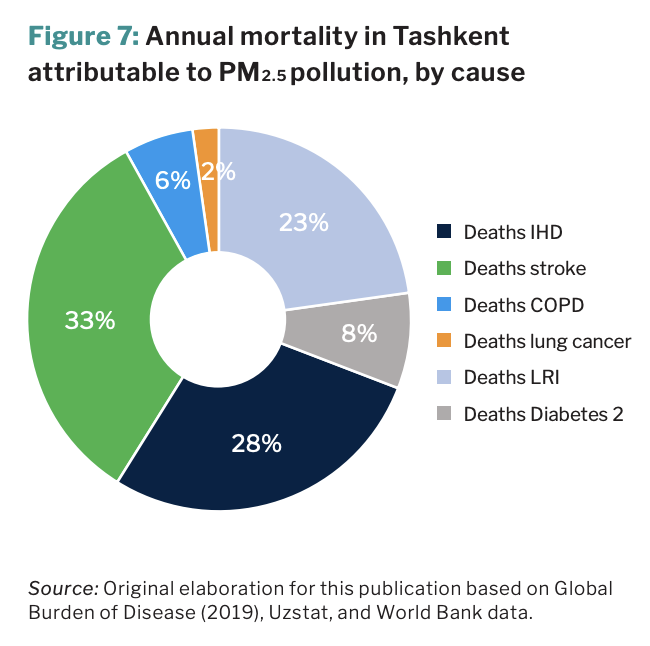A new World Bank report reveals that Tashkent’s PM2.5 pollution levels are over six times higher than the WHO’s recommended limit. The report, produced in collaboration with Uzbekistan’s Ministry of Ecology, Environmental Protection, and Climate Change, highlights the severe health and economic impact of air pollution in the capital. It calls for urgent reforms in air quality management, targeting key sectors such as heating, transport, and industry to reduce emissions and improve public health.

The report indicates that Tashkent’s annual average concentration of PM2.5 exceeds WHO guidelines by over six times, with levels reaching as high as 39.3 µg/m³ in some parts of the city. The WHO’s recommended annual average limit is 5 µg/m³. In terms of health, this level of pollution is estimated to result in about 3,000 premature deaths annually, causing a welfare loss of approximately $488.4mn, equivalent to 0.7% of Uzbekistan’s GDP

The report reveals alarming statistics regarding the levels of PM2.5 pollution in Tashkent. Ambient concentrations of PM2.5 peak during the winter months, significantly exceeding WHO air quality guidelines. On average, the annual concentration of PM2.5 in Tashkent is more than six times higher than the WHO’s recommended threshold of 5 µg/m3. This level of pollution is associated with severe health consequences and incurs an economic cost equivalent to 0.7% of Uzbekistan’s gross domestic product (GDP).

The study identifies key sources of PM2.5 pollution in Tashkent. Human-caused pollution stems primarily from heating (28%), transportation (16%), and industrial activities (13%). Additionally, cross-boundary sources such as windblown dust account for 36% of PM2.5 pollution during the summer, while commercial and residential heating dominate as the primary pollutants in winter.
In response to these findings, the report presents a comprehensive Air Quality Management (AQM) roadmap, offering a series of recommendations aimed at reducing pollution levels. These recommendations include:
•Updating air quality standards and legislation in Uzbekistan
•Developing a national AQM strategy and establishing a coordination mechanism
•Implementing sector-specific policies in the industrial, transport, and heating sectors to reduce emissions
•Addressing cross-boundary sources of pollution, such as windblown dust
The roadmap also emphasizes the need for investments in emission reduction measures across sectors to improve the health and well-being of Uzbekistan’s population. These efforts, the report argues, require coordinated action at local, national, and regional levels, as AQM is a challenge that can only be addressed through comprehensive, multisectoral collaboration.
The Government of Uzbekistan has acknowledged the report’s findings and recognizes the need for a collaborative approach to managing air quality. The World Bank’s report marks a crucial step in addressing the environmental challenges faced by Tashkent and aims to guide future policy-making to improve the city’s air quality and protect public health.
Comments (0)